 |
Plant Portrait : Houttuynia cordata 'Chameleon' |
| Home Recommend This Site To A Friend |
|
By Sandy Leven 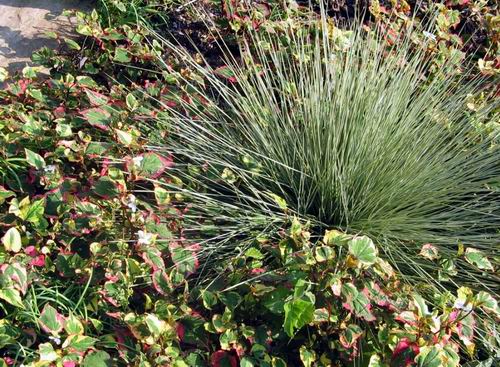
With Aciphylla simplex This much-maligned plant is one of my favourites in the garden. It has a reputation for being invasive, which it can be and of being garish which it certainly is. I grow it at the top of a 'scree bed' beside a path. It is restricted on two sides and slowly makes its way across the 'scree'. It has been in situ for at least 10years and is now a nice clump. Even better, it has encircled a fine plant of Aciphylla simplex and the two co-exist with no trouble. In time I will have to chop back some of its roots and will have material to [plant down by the roadside. Here the soil is much wetter and I hope it romps away down there. Perhaps it will tame the Alchemilla mollis, a plant which we are told is much loved by flower arrangers. The Alchemilla has seeded itself into all my neighbours gardens over the past 25 years and is making headway towards the next street but it is not condemned for this behaviour. Why should the chameleon be tarred with the epithet. "invasive" if the Alchemilla is recommended? 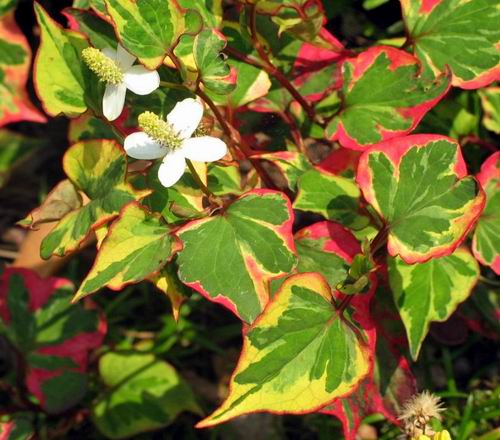
Houtinya chamaelion That Chameleon is spectacular can not be doubted. Look at those colours in its leaves. There is some green, a lot of creamy yellow and a lot of red. In hot summers like this the red is even more pronounced. Some leaves are green and yellow initially and as the weeks pass, they become suffused with red. I like the tricoured leaves best but all are interesting. Trying to pick out the best leaf in a Houttuynia cordata clump is like finding the best leaf on a sugar maple in Autumn. The AGS Encyclopaedia [my favourite reference book, by the way!] says the leaves smell of Seville oranges when they are bruised. I don't know whether they are bruising the oranges or the Houttuynia. The leaves do have smell when crushed. Perhaps this verges towards 'citrussy' but my daughter pronounced it 'disgusting'. The might have a use in home-made smelling salts for rousing slumbering gardeners. They have little future 'chez Chanel'. 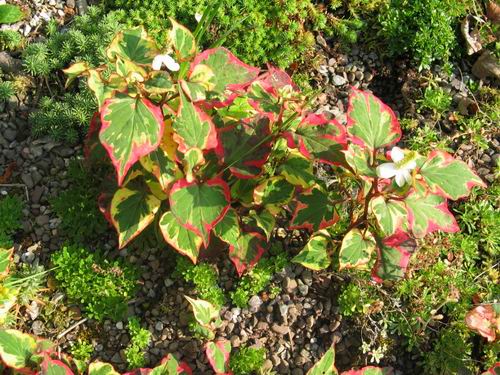
The flowers are interesting. They are about 1inch, [2cm] across. Four, occasionally 5 or 6, pure white bracts sit at the base of a relatively tall central cone, which is made up of lots of insipid little flowers. This arrangement is akin to that of members of the Compositae family, into which a non-botanist like myself might have placed the Houttuynia. It is in fact in the Saururaceae family, of which I know nothing else! 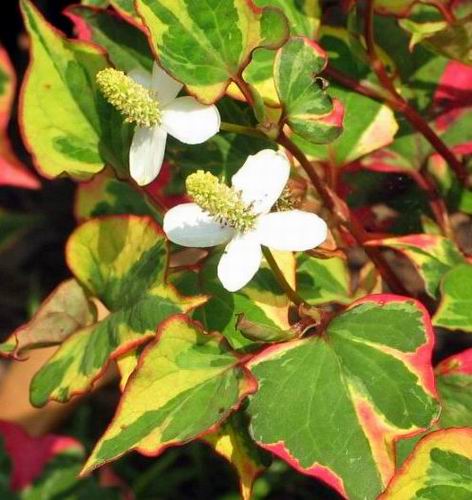
Houttuyinia Flower The first stalks appear in mid summer, gently pushing up and slowly unfurling to reveal their wonderful leaves. At the first sign of frost it disappears below ground till next summer. The dead stalks are easily pulled away and the garden tidied up. Be careful round the Aciphylla! 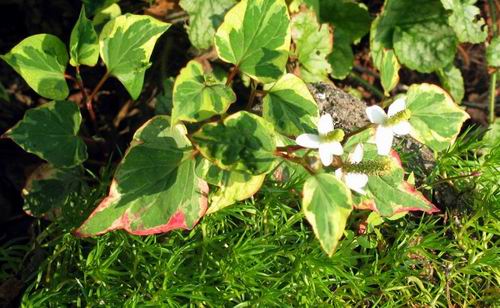
Underground, the plant spreads by creeping rhizomes. Its spread in my garden is slow but for this I am thankful. Many other plants are liable to recede from year to year and eventually they disappear. The AGS Encyclopaedia says it grows from the Himalaya to Japan and Java. I firmly believe that its Oriental origins are revealed in its bright colouring. This could be the only plant from Java, which is hardy in my garden. Perhaps the reference to Seville oranges in the smell of its leaves is confusion between orange varieties? Seville -Jaffa - Java -I know it's unlikely but you never know! Dunblane and Java are rarely compared to one another but perhaps there is a hillside in that far away land that is just like Perthshire. When you see it for sale, there seem to be pots with good foliage and pots with better foliage. When planted out they should all be equally spectacular as in a patch each leaf is slightly variable. Don't buy the plain green form, ie-plain Houttuynia cordata. The Bank of Scotland in Dunblane has a clump of this at the edge of the entrance and it is a sad, unhappy looking thing compared to the selection 'Chameleon'. Houttuynia cordata 'Chameleon' will thrive in many situations in the garden. The colours, especially the yellow and red, are best in good sunlight. It will brighten up dry shade, where it spreads only slowly, which is another plus. I have seen it growing in baskets plunged into ponds where it was quite happy. I presume the pots are removed before the pond freezes over in winter. One year in my enthusiasm for the plant I took two pans to the Discussion Weekend Show, St Andrews I think. I will not repeat what was said to me far less the comments which I overheard. The judges were just not up to the task. They did not appreciate my plants. NAS? What's that? 'Not according to schedule' I suppose but I prefer 'Nearly always stunning'. A few years later at an AGS show the clone 'Tricolour' was not excluded. It even got a prize. Well done that exhibitor! 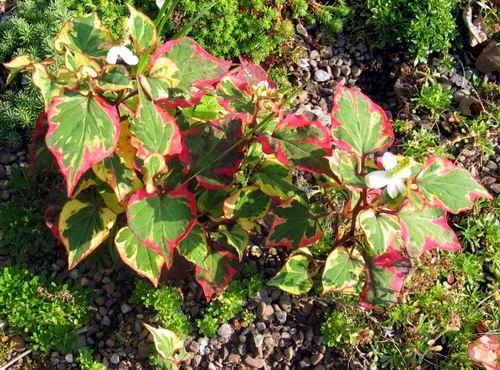
Pay the sceptics and doubters no heed. Up here in Scotland this plant is less invasive than Lily of the Valley and Gunnera magelanica. It is more beautiful than most lamiums. It is dependable. It is reliable. You can usually find it for sale in garden centres. If not, I have some to spare. Clumps of Houttuynia cordata for Daphne or snowdrops any day! Houttuynia cordata is a perennial with the most wonderful foliage. Ignore it if you dare. Without it, you will have to wait for autumn cyclamen leaves to excite you. Perhaps I should dig some up for the Autumn Discussion Weekend show in Elgin? See you there. Bring some colour to the show. 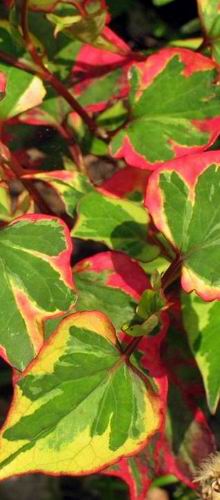
^ back to the top ^ |